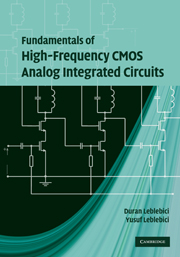Book contents
- Frontmatter
- Contents
- Preface
- 1 Components of analog CMOS ICs
- 2 Basic MOS amplifiers: DC and low-frequency behavior
- 3 High-frequency behavior of basic amplifiers
- 4 Frequency-selective RF circuits
- 5 L-C oscillators
- 6 Analog–digital interface and system-level design considerations
- Appendix A Mobility degradation due to the transversal field
- Appendix B Characteristic curves and parameters of AMS 0.35 micron NMOS and PMOS transistors
- Appendix C BSIM3-v3 parameters of AMS 0.35 micron NMOS and PMOS transistors
- Appendix D Current sources and current mirrors
- References
- Index
3 - High-frequency behavior of basic amplifiers
Published online by Cambridge University Press: 05 June 2012
- Frontmatter
- Contents
- Preface
- 1 Components of analog CMOS ICs
- 2 Basic MOS amplifiers: DC and low-frequency behavior
- 3 High-frequency behavior of basic amplifiers
- 4 Frequency-selective RF circuits
- 5 L-C oscillators
- 6 Analog–digital interface and system-level design considerations
- Appendix A Mobility degradation due to the transversal field
- Appendix B Characteristic curves and parameters of AMS 0.35 micron NMOS and PMOS transistors
- Appendix C BSIM3-v3 parameters of AMS 0.35 micron NMOS and PMOS transistors
- Appendix D Current sources and current mirrors
- References
- Index
Summary
It was already discussed in earlier chapters that the amplitude and the phase responses of amplifiers change with frequency, either intentionally or non-intentionally. In some applications, a specific frequency response is desired, for example a band-pass characteristic for an LNA (here, LNA stands for “low-noise amplifier” – the low-noise input stage of a receiver). To shape the frequency response according to our needs, we use reactive components; such as inductors and capacitors. For other applications a flat frequency response is required; however, gain inevitably drops at higher frequencies. The reason for this “non-intentional” change of the frequency response is the “parasitic” components of the circuit; i.e. all non-avoidable reactive (usually capacitive) components related to the devices and the interconnections. To investigate the essential frequency-dependent behaviors of amplifiers, it is necessary to improve the small-signal equivalent circuit of a MOS transistor developed in Chapter 2.
The small-signal equivalent circuit of a MOS transistor biased at a certain operating point in the saturation region was given in Chapter 2, Fig. 2.6. To extend the usability of this equivalent circuit to high frequencies (in other words, to radio frequencies), it is necessary to add the parasitic capacitances and the parasitic resistances that were discussed in Chapter 1, as shown in Fig. 3.1(a). In this equivalent circuit RD, RS and RG are the series resistances of the corresponding regions of the device, where d′, s′ and g′ represent the so-called “internal nodes” that are inaccessible from the device terminals; d, s and g represent the external terminals.
- Type
- Chapter
- Information
- Publisher: Cambridge University PressPrint publication year: 2009



